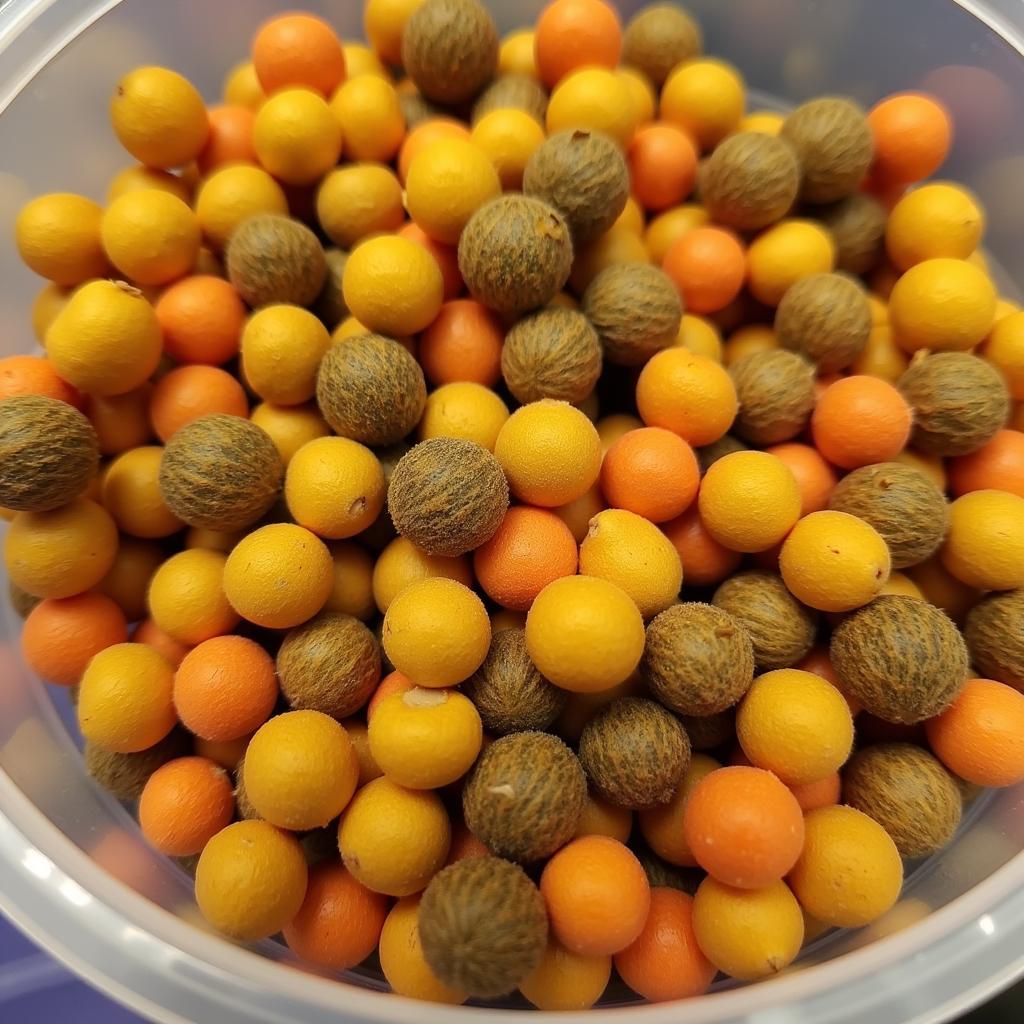Fish Food Pond Pellets are a staple for many pond owners, providing a convenient and nutritionally balanced diet for their finned friends. But with so many options available, how do you choose the best fish food pond pellets for your specific pond and its inhabitants? This guide will dive deep into the world of fish food pond pellets, exploring everything from nutritional needs to choosing the right pellet size and type.
Understanding the Importance of Quality Fish Food Pond Pellets
 High-Quality Fish Food Pellets for Optimal Fish Health
High-Quality Fish Food Pellets for Optimal Fish Health
Providing your fish with high-quality fish food pond pellets is essential for their overall health, growth, and vibrant coloration. Just like us, fish require a balanced diet with the right proportions of proteins, fats, carbohydrates, vitamins, and minerals. Choosing the wrong food can lead to poor growth, weakened immune systems, and a dull appearance. Investing in quality fish food pellets for ponds ensures your fish thrive and your pond remains a healthy ecosystem.
Decoding Fish Food Pond Pellet Ingredients
What exactly goes into those pellets? A good quality fish food will list its ingredients clearly. Look for pellets that list fish meal, shrimp meal, or other high-quality protein sources as the primary ingredients. Avoid pellets with fillers like corn or wheat as the main component, as these offer little nutritional value.
Protein Powerhouse: Why it Matters
Protein is crucial for muscle development and overall growth in fish. A higher protein content is particularly important for younger fish and those species known for their rapid growth.
What’s the ideal protein percentage? It depends on the fish species. For example, Koi and goldfish benefit from a diet with around 30-40% protein, while some predatory fish may require even higher levels.
Different Types of Fish Food Pond Pellets: Finding the Perfect Match
Not all fish food pond pellets are created equal. They come in various forms, each designed for specific fish species and feeding habits:
- Floating Pellets: Ideal for surface feeders like koi and goldfish, allowing you to observe their feeding habits and ensure they are getting enough food.
- Sinking Pellets: Best for bottom feeders like catfish and certain types of carp. These pellets sink quickly to the bottom, preventing waste and ensuring these fish get their share.
- Slow-Sinking Pellets: A middle ground between floating and sinking pellets, suitable for fish that feed in the mid-water column.
Choosing the correct type of pond fish food pellets is key to preventing food waste and ensuring all your fish are adequately nourished.
Sizing it Up: Choosing the Right Pellet Size
Just as important as the type of pellet is its size. Feeding your fish pellets that are too large can lead to digestive issues, while pellets that are too small can be difficult for larger fish to consume. Choose a pellet size that is appropriate for the size of your fish’s mouth. Many brands offer different pellet sizes for various life stages, from fry to adult fish.
What size pellets should I use for my fish? Match the pellet size to the size of your fish’s mouth.
Seasonal Feeding Strategies: Adapting to Changing Temperatures
Fish metabolism slows down in colder water, meaning they require less food. During the warmer months, when fish are most active, they need a higher protein diet to support growth and energy levels. Consider switching to a lower protein, fish pond food pellets during the winter months, or reduce the feeding frequency. There are also specialized best food for koi growth formulas available.
Conclusion: Nourishing Your Pond with the Right Fish Food Pellets
Choosing the best fish food pond pellets requires careful consideration of your fish species, their feeding habits, and the season. By understanding the importance of quality ingredients, pellet types, and size, you can ensure your fish receive the optimal nutrition they need to thrive. Remember to check out purina catfish food for a reputable brand. By investing in the right fish food pond pellets, you’re investing in the health and vitality of your pond ecosystem.
FAQ
- How often should I feed my pond fish?
- Can I overfeed my fish?
- What are the signs of a nutritional deficiency in fish?
- How do I store fish food pellets properly?
- What is the difference between fish meal and fish oil in fish food?
- Should I supplement my fish’s diet with live food?
- Can I use the same fish food for all types of pond fish?
Need help with your pond or fish care? Contact us at Phone Number: 02437655121, Email: minacones@gmail.com Or visit us at: 3PGH+8R9, ĐT70A, thôn Trung, Bắc Từ Liêm, Hà Nội, Việt Nam. We have a 24/7 customer service team.